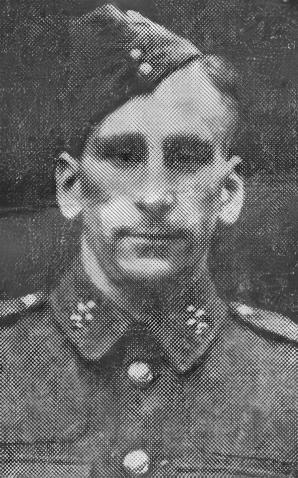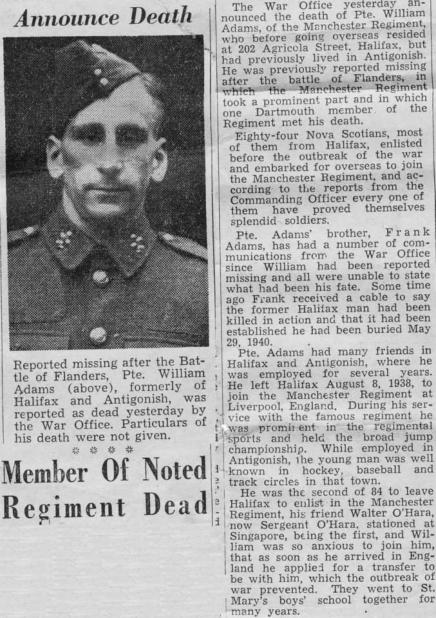
copyright © Wartime Heritage Association 2012-2024
Website hosting courtesy of Register.com - a web.com company
Wartime Heritage
ASSOCIATION
Remembering World War II
William Douglas Adams


Name:
William Douglas Adams
Rank:
Private
Service No.:
3530361
Unit:
2nd Battalion, Manchester Regiment, British Royal Army
British Expeditionary Force (BEF)
Date of Birth:
July 8, 1918
Place of Birth:
Halifax, Nova Scotia
Date of Enlistment:
August 8, 1938
Place of Enlistment:
Ashton-under-Lyne, England
Address at Enlistment:
Agricola Street, Halifax, NS
Next of Kin:
Frank Adams, Halifax, NS (Brother)
Occupation:
Farm labourer
Date of Death:
Between May 10 and May 19, 1940
Age at death:
22
Cemetery:
Dunkirk Town Cemetery, Coudekerque-Branche, France
Grave:
Plot 2, Row 4, Grave 44
Commemorated on Page 10 of the Second World War Book of Remembrance
Displayed in the Memorial Chamber of the Peace Tower in Ottawa on January 12, 13 and 14
William (Bill) Douglas Adams was the son of James Rupert Adams (1864-1937) and Margaret Jane (Lindloff)
Adams (1868-1929). He had two brothers, Francis (Frank) and John, and a sister Cecilia (who died in infancy
of cholera; at 11 months).
“The trio spent their childhood years in urban Halifax, where the family resided on Clifton, Bishop,
and Grafton Streets at various times. [After Bill’s parents’ deaths, his older brothers were old enough
to support themselves, but Bill was only 14]. Several secondary sources state that Bill was placed in
the care of St. Patrick’s Boys’ Home, Halifax […] .
As no official documents exist confirming Bill’s admission to the Boys’ Home, it is unclear how long he
remained there. It was common practice for St. Patrick’s to arrange for its older boys to work as farm
labourers in various Nova Scotian communities. This may explain how Bill made his way to the
Antigonish area around 1935. He first resided with a Roderick MacPherson, address unknown, before
relocating to the home of Arthur Dexter, East Main St. For several generations, the Dexter family
operated a small farm and orchard close to the railway station.”
Based on a school hockey photo, Bill attended high school at Morrison in Antigonish. With considerable
unemployment in Nova Scotia, Bill became one of the ‘Manchester 100’. Lieutenant-Colonel R. B. Willis, DSO,
a veteran of the South African War and former officer with the Manchester Regiment of England, was serving
with the Halifax detachment of the Royal Canadian Regiment, and he was actively recruiting for the Regiment
in Halifax. Approximately 85 other Nova Scotians enlisted with the Manchesters.
William departed Halifax in July 1938 for the UK, and enlisted on August 8, 1938, at the Ladysmith Barracks
Recruit Depot in Ashton-under-Lyne, historically in Lancashire, and a market town in Tameside, now part of
Greater Manchester in England.
“Bill completed six months’ basic training at the Ladysmith Barracks Recruit Depot […]. Local families
took the young Canadians under their wing and frequently provided them with accommodations during
their leaves. Upon completing his training, Bill reported to Aldershot, England, where he was assigned
to the Manchester Regiment’s 2nd Battalion.
Two years prior to Bill’s enlistment, British military authorities had selected the 2nd Battalion for
conversion to a fully mechanized machine gun unit. Following a one-year period of intense training,
the transformation was completed, and the unit entered quarters in Tournai, Barracks, Marlborough
Lines, Aldershot.
Two days after the September 1, 1939, German invasion of Poland, Great Britain formally declared
war on Germany, a decision that resulted in mobilization of the country’s military forces. The
Manchester Regiment’s 2nd Battalion was attached to British I Corps’ 2nd Infantry Division and
immediately prepared to depart for the continent with the British Expeditionary Force.
On September 23, 1939, 2nd Battalion’s personnel landed at Cherbourg, France. Over subsequent
days, its soldiers and their 2nd Division comrades made their way northward to the Franco-Belgian
border, where they established camps between Orchies, France, and Saint-Amand, Belgium. Personnel
remained in the sector throughout the winter of 1939-40, improving fortifications and communication
facilities despite exceptionally cold weather.”
William’s exact date of death is unknown, but the Commonwealth War Grave Commission indicates he died
sometime between May 10 and May 19, 1940. The chaos of the fighting after Germany invaded Belgium,
France, Luxembourg, and the Netherlands on May 10, 1940, make the determination of the date impossible.
He was reported missing after the Battle of Flanders in the early days of the war prior to the Battle of
Dunkirk. He was interred May 29, 1940.
Sources:
Bruce MacDonald and the Antigonish Cenotaph Project 2
findagrave
Canadian Virtual War Memorial
David Gilhen and the Facebook page, The Halifax 100 – Manchester Regiment WWII


Halifax Herald (June 1940)




- World War I - Menu
- WWI Stories and Articles
- Photos - Yarmouth Soldiers
- Selection of World War I Songs
- WWI Casualties of Yarmouth, NS
- Those Who Served - Yarmouth, NS
- WWI Casualties Digby Co. NS
- WWI Casualties Shelburne Co. NS
- Merchant Mariners (1915) Yarmouth, NS
- Canadian Forestry Corps - Non Yarmouth Birth/Residence Enlistments
- US Draft Registry - Yarmouth NS Born


- World War II - Menu
- WWII Stories and Articles
- Telegraphist Air Gunners
- WWII Casualties of Nova Scotia
- US Casualties with NS Connection
- Far East/Pacific Casualties with NS Connection
- Merchant Navy Casualties Nova Scotia
- Nova Scotia WWII Casualties Holten Canadian War Cemetery
- D-Day Casualties - Nova Scotia
- CANLOAN Program Casulaties - Nova Scotia
- Battle of the Bulge Casualties - Nova Scotia
- WWII Casualties Yarmouth NS
- Yarmouth Casualties - RCAF RAF Canadian Army WWII
- Yarmouth Co., Marrages WWII
- Casualties Non-Born/Residents with Connection to Yarmouth Co., Nova Scotia.
- WWII Casualties Digby Co., NS
- Non-Nova Scotian WWII Casualties Buried in Nova Scotia
- WWII RCAF Casualties Aged 16-18
- Brothers/Sisters Who Served - World War II













